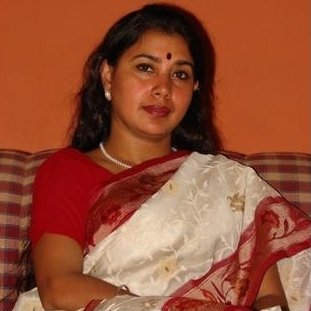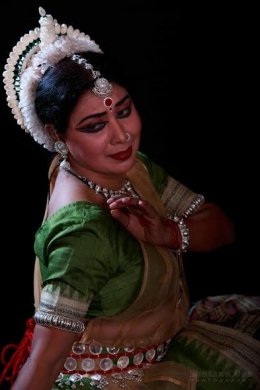
|
 |

|
 |
Aruna Mohanty on Dhauli - Kalinga Mahotsav - Nita Vidyarthi e-mail: nitavidyarthi@gmail.com June 8, 2016  Acclaimed Odissi dancer, teacher and choreographer Guru Aruna Mohanty, Secretary and Creative Director of Orissa Dance Academy (ODA) keeps her guru's torch ablaze by organizing the Dhauli-Kalinga Mahotsav as its Festival Director regularly at the foothills of the Vishwa Shanti Stupa. A fantastic organizer, Mohanty gives the background and instillation of this annual event, which has a strong martial arts component alongside the classical dance form. This clarifies to many why the Kalinga Martial Arts Festival, a brainchild of Dr. Ileana Citaristi, merged with the Dhauli Festival started by her Guru Gangadhar Pradhan. How did the Kalinga and Dhauli Festivals become a combined event? In 1985, my Guru Gangadhar Pradhan dreamt of organizing festivals at heritage sites not only to promote the performing arts but through them highlight the national and cultural heritage and the heritage sites in order to bring back history in our lives so that we cherish the memories of our great ancestors who had built these huge historical monuments as the cultural milestones. He started Konark Natya Mandap Festival in 1989. So ODA had been organizing this dance and music festival for almost 25 years. After that, Guruji's family is looking after this festival. But after 2003, Guruji said that ODA's activities should not be restricted to Konark but should branch out to other heritage sites also. Accordingly, he laid the foundation stone of the Dhauli Festival by purchasing two acres of land at the foothills of Dhauli (the Vishwa Shanti Stupa). It is at the outskirts of Bhubaneswar, so it draws people from both the urban, the semi-urban areas as well as the 10-20 villages around it . That's why Guruji never thought of restricting it to the classical dance forms. It should have classical, folk and martial art forms so that it will kind of represent the culture of all sections of life. How did it start? It started in a very small way but gradually took shape. After Guruji passed away, the entire thing has been organized by the Orissa Dance Academy. Since I am Guruji's senior-most disciple and was already the secretary of the Academy when Guruji was alive, I am carrying out the legacy of organizing this festival the way he had dreamt of. Every day we are adding one more stone and the edifice is slowly getting shape. Hopefully, we would be able to realize his dream of making it a Shanti Vihar like Kalakshetra or Dakshinachitra where all the allied art forms of Odisha which have been instrumental in restructuring, influencing and reconstituting Odissi as an art form would be represented. I want to put these allied art forms like music, folk- dance forms, Sankeertan and Pala which have enriched Odissi in terms of steps, vocabulary, movements, musical structures, rhythmic variations and aharya under one umbrella. I also want to have other features which are ancillary and would complement the dance so that it is educative. People can come, watch and learn about our culture and should be a part of the educational curriculum for schools to visit and learn. Is the stage a permanent construction? Yes. It is a full construction. That is a permanent stage. I have given it a cave-like look this year through the sets but it is a pucca stage with wing walls. So, on the walls I have made the cave for the musicians to sit. I wanted the rock-cave effect which would appear to gradually extend to a mountain, atop which is the Dhauligiri Stupa. Every year I can make a different theme so that the stage is lit up in a different way to complement the Dhauligiri. Why were the martial arts included when there had already been a separate festival? Actually, since Dhauli happened, from the beginning we had our martial arts like Chhau and other forms of dance in our performing schedule also. In 2003, Ileana Citaristi had suggested to the Government of Odisha for an exclusive Martial Arts Festival which also started in 2003 but on top of the stupa, on the space in front of the main Dhauli Stupa. Since it is a completely Government Festival like Konark and Rajarani, Ileana and Art Vision was asked to look after the organizing part like contacting, selecting artists and looking after the artists when they are here. But the total money was coming from the government. Like now the Konark Festival is a tourism festival but is administered by the Odisha Sangeet Natak Akademi. Similarly Ileana was in charge of organizing the Kalinga Festival.  And you? For Kalinga fest we were not involved. We were looking after Dhauli. So in the same year and almost the same month two festivals were happening at Dhauligiri. The space in front of the stupa was insufficient for martial arts and could accommodate only a maximum of 200 people to sit. On the contrary, Dhauli fest attracts 2000 people every day. Since government was totally funding Kalinga Festival and also giving us (ODA) some money, the government thought that if the two are merged then the martial element will be protected as the stage is large, at a same time a larger crowd can watch the festival and the government will save a lot of money. It was merged five years back so it became The Dhauli Kalinga Mahotsav. That's how Art Vision is also a part of it because they help us to select the artist, contact them and bring them here. Why then the confusion? No! When it is written 'Dhauli Kalinga Mahotsav', it is Dhauli showcasing all other art forms and Kalinga kind of focuses on the martial arts section. It is not confusing! Martial arts are a major component in the Mahotsav. One half is classical and the other martial arts. Experience of the last ten years showed that only martial arts were not attracting that many audiences. For the first year we had three days of Dhauli-only classical and folk-art forms and last two days only martial art forms. The Government administration realized that the last two days did not draw as many audience as the first three. So we thought it proper that there would be both classical and martial arts daily so that the people would get the flavour of both - which is why the theme is War and Peace. War is not to create bloodshed and devastation but to protect ourselves and restore peace. So if the warriors are not there, who will maintain peace? I noticed a large part of the audience were college students. For many years, I have noticed that for seminars and good performances we have a set group of audiences. Our audience base has to be expanded. We have to involve the youth through movements like Spic Macay to give exposure and involve them to become future rasikas. I appreciated the holy chant of peace and execution by the Gotipua. Are they a part of ODA? Yes. My Guru Gangadhar Pradhan was a Gotipua. He wanted to bring back the gotipuas into the mainstream and these are boys from interior Odisha, mainly from Puri district and Brahmagiri. When they are above 14 years old, we absorb them in the Orissa Dance Academy. Contact Aruna Mohanty: aruna.odissi@gmail.com Nita Vidyarthi is a veteran critic of performing arts and writes on dance, music and theatre in leading publications. Post your comments Unless you wish to remain anonymous, please provide your name and email id when you use the Anonymous profile in the blog to post a comment. All appropriate comments posted with name & email id in the blog will also be featured in the site. |